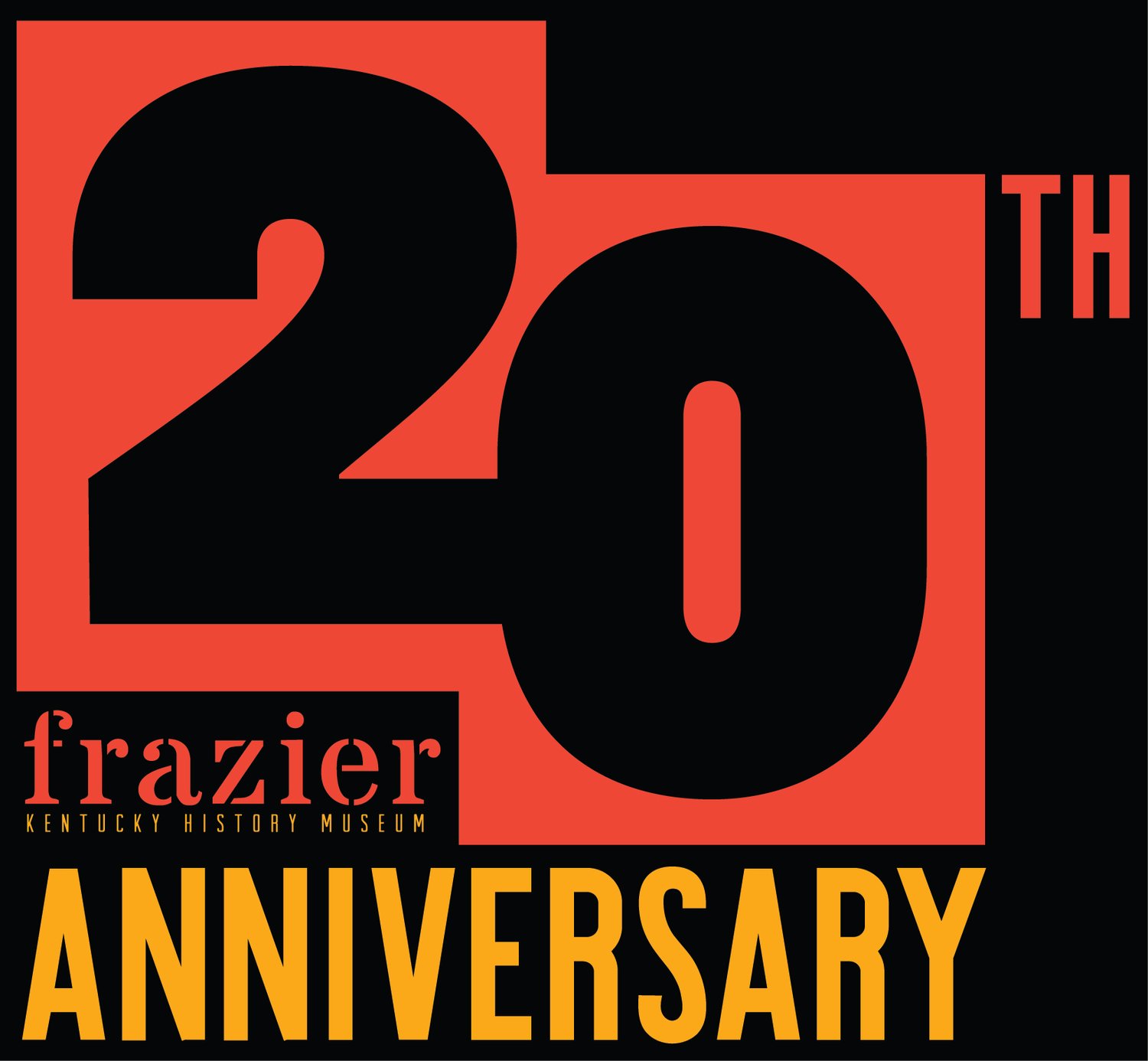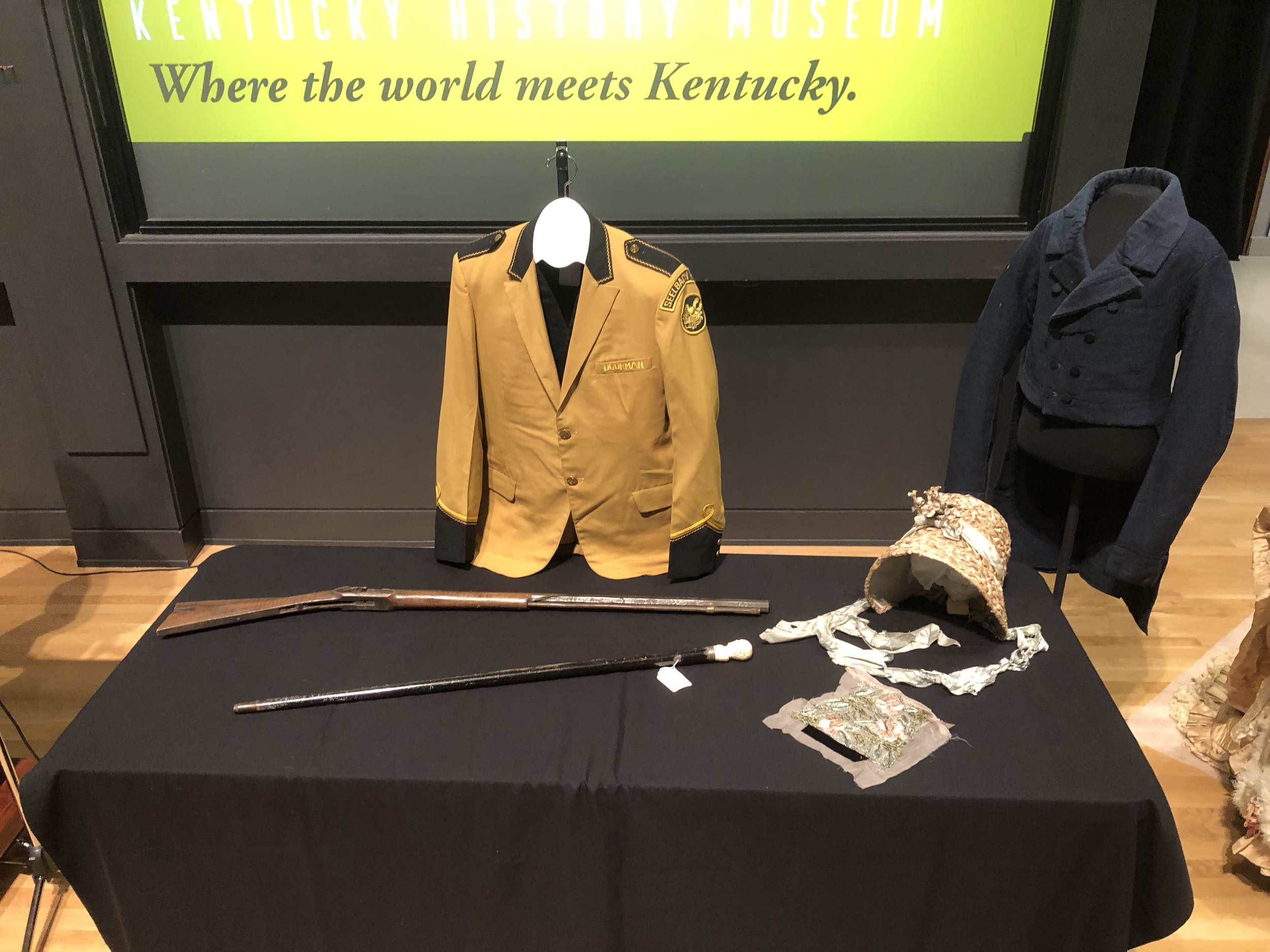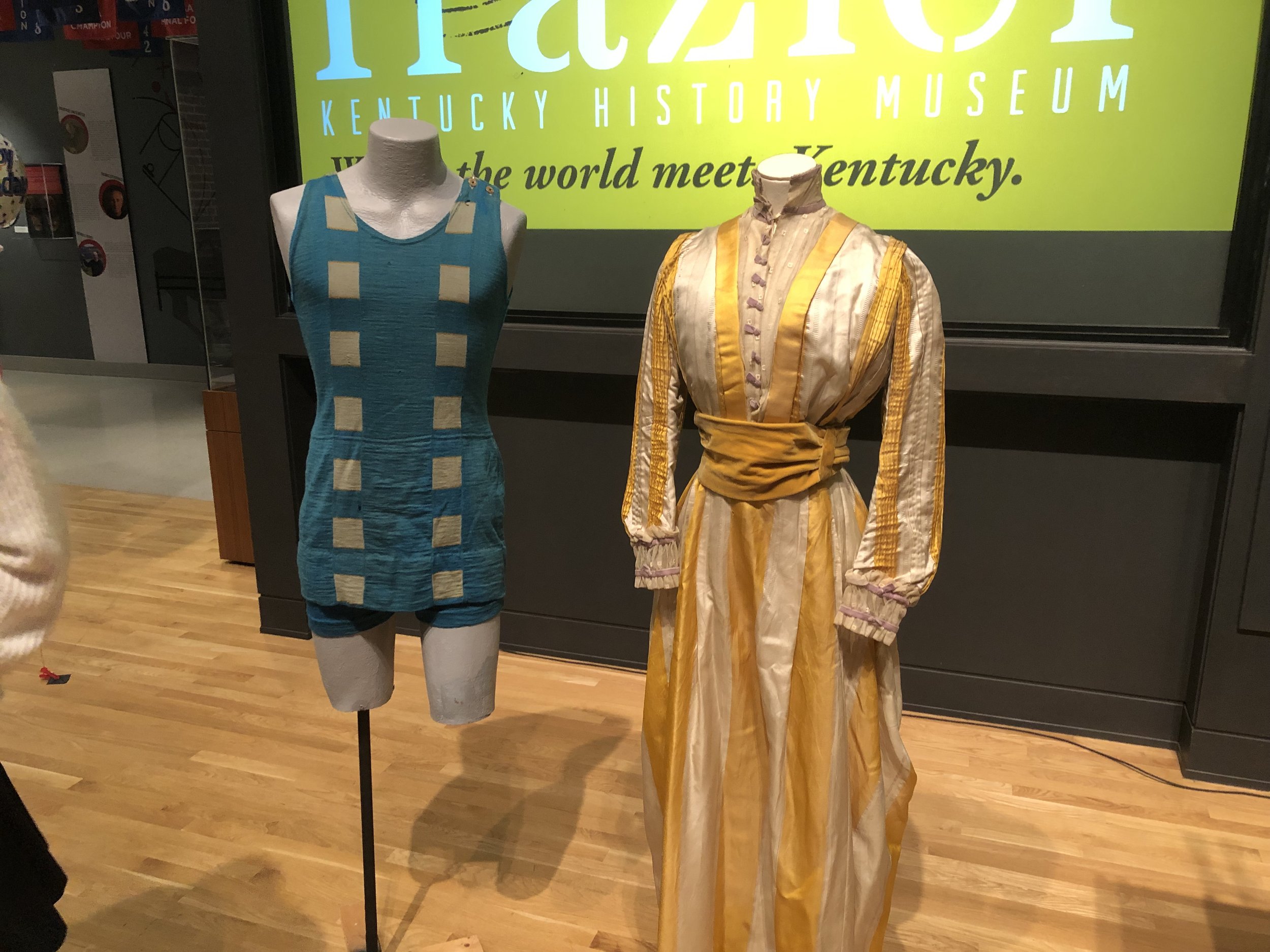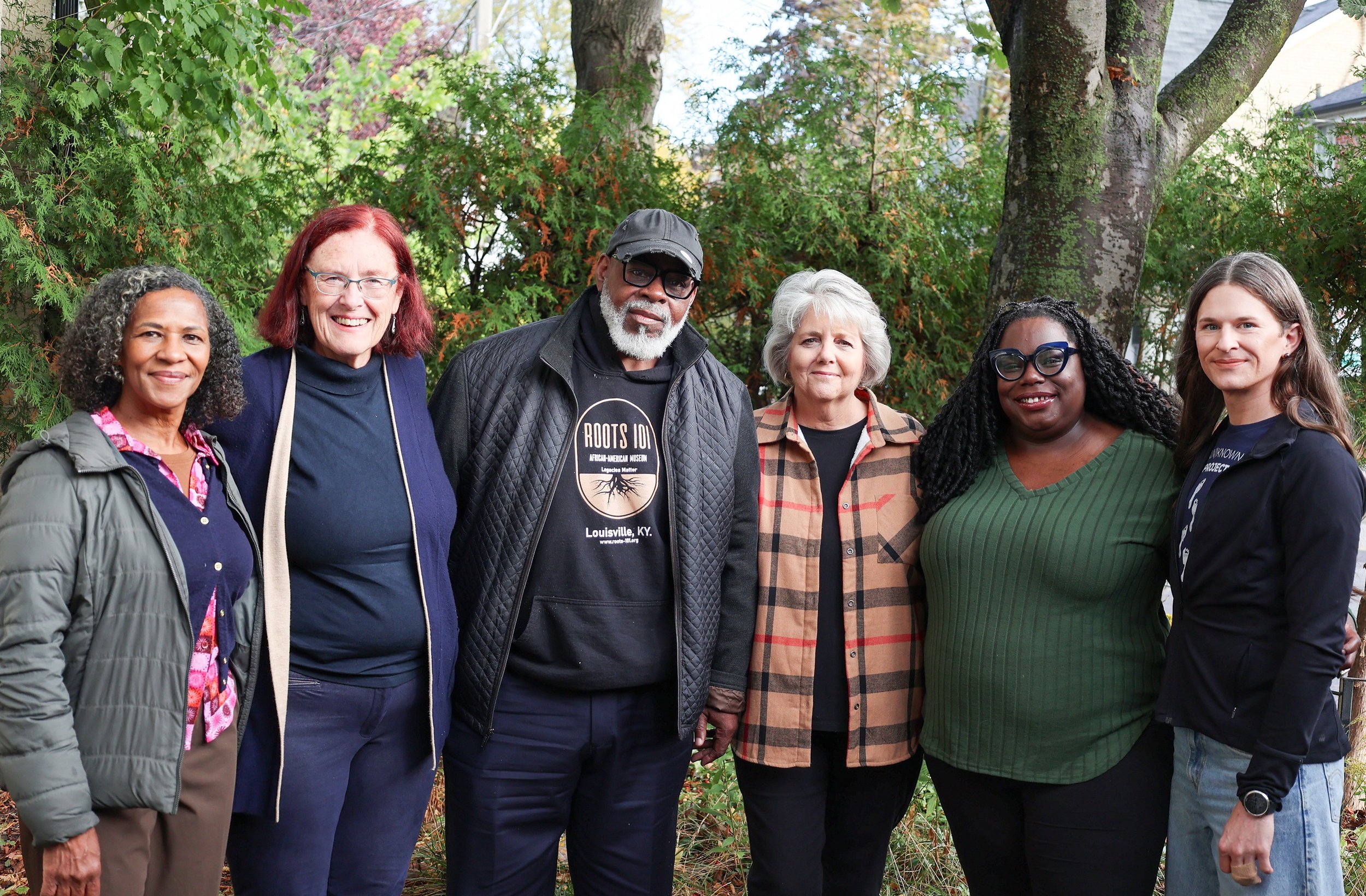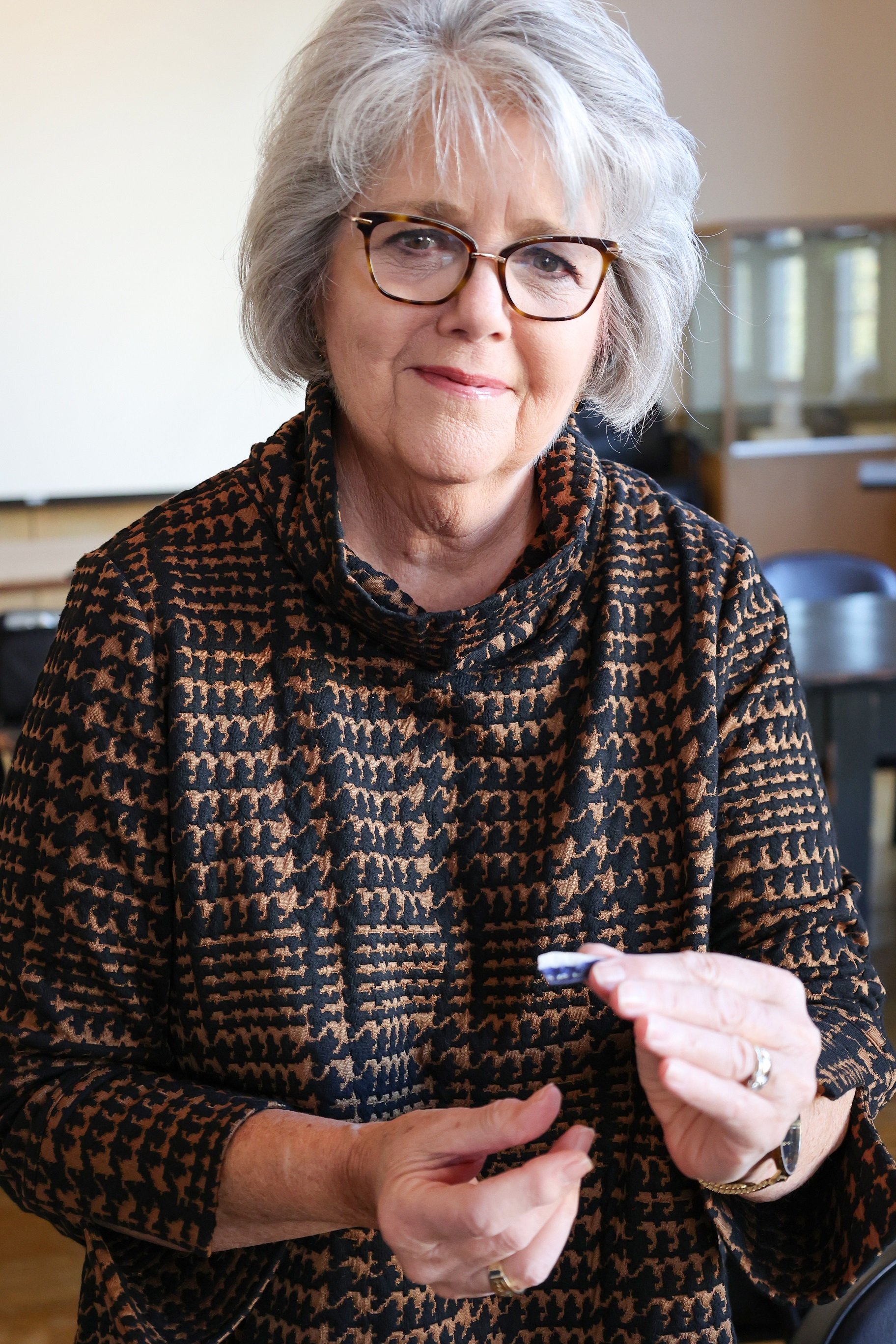The 10 Best Frazier Weekly Articles of 2023
Each Monday at 7 a.m., we send you a new issue of Frazier Weekly—chock-full of original articles, videos, and interviews, contributed by Frazier staff members.
But today, we’re taking the week off!
So to tide you over we’ve compiled the ten best Frazier Weekly articles of 2023.
Before we look back at the best of last year, we’ve got three announcements about 2024.
First, Kentucky Living—a magazine that circulates to over 475,000 addresses, making it the most widely read publication in Kentucky—has just featured the Frazier History Museum! Recently, the Kentucky Living editorial team asked us to curate a list of ten objects in our collection that represent Kentucky. Compiled by a team of six Frazier staff members, the listicle we wrote has just been published. It shines a light on “the breadth of cultural practices in Kentucky history—from agriculture to livestock, immigration, industry, mining, childrearing, distilling, traditional music, and civil rights.” You can read it online or in the print edition of the magazine’s January issue.
Second, we’re temporarily adjusting our hours of operation: from January 9 through January 31, the museum and museum shop will be closed on Tuesdays and Wednesdays. But don’t worry! Starting February 1, we’ll go back to operating seven days a week.
Third, our first program of 2024 is next week! Join us Sunday, January 14, 2 p.m., for Kentucky Quilts and Quiltmakers with our special guests, author Linda LaPinta and quilt artists “Sunshine Joe” Mallard and MJ Kinman. Our Frazier Winter Book Club—which is always taking new members!—will convene at 1 p.m. to discuss LaPinta’s book.
As always, thanks for reading. If you enjoy Frazier Weekly, please tell your friends, family, and colleagues to subscribe. Next week’s issue will reveal the theme we’re adopting for 2024, so stay tuned.
Happy new year!
Simon Meiners
Communications & Research Specialist
Frazier History Museum
The Ten Best Frazier Weekly Articles of 2023
Kentucky Rivalries: Mr. Ron Butler on 1969–70 Male Basketball
Published in the March 6, 2023, issue.
By the end of the week, we will know which boys basketball teams in the Commonwealth have advanced to represent their respective regions in next week’s Boys’ Basketball KHSAA Sweet 16 Tournament. To mark the occasion, and to bring attention to one of the subjects of our Kentucky Rivalries exhibition, I recently sat down with fellow Frazier employee Mr. Ron Butler.
The 1969–70 State Champion Male Bulldogs boys basketball team. Ron Butler is seated in the first row, first from the right. Credit: Ron Butler.
Gainfully employed (and beloved by staff and management) at the Frazier for over seventeen years, the seventy-year-old is as steadfast in his work ethic and faith as they come. Yet, Butler is also a humble man. Consequently, one of the things that people outside the museum might not realize about Butler is that he was a star athlete at Male High School back in the late 1960s and early `70s. In fact, Butler was one of the reserves who helped steady the Bulldogs towards winning back-to-back state championships in basketball in the early `70s. The team included stars like Bill Bunton, Henry Huskey, and Ron’s friend, William “GeeGee” Gordon.
In this thirty-minute interview, among other things, we learn how Butler almost ended up playing for Male’s archrival duPont Manual High School, why a coach of an opposing team was so upset about playing against Butler and Gordon that he almost forfeited a game, what happened during the infamous 1970 Male-Trinity football game, and why during the 1980s Butler resumed playing basketball after a long hiatus.
Without these stories, Ron Butler is already a special person. Yet, because of his exploits, Butler holds a place of honor in our Kentucky Rivalries exhibition. After listening to this interview, we here at the Frazier hope that you will agree.
Brian West
Teaching Artist
From the Collections: Easter Bunny and Chicken Nodders, c. 1950
Published in the April 3, 2023, issue.
“Here comes Peter Cottontail!”
This weekend, egg hunts, parades, official photos with the Easter Bunny, and well-attended Sunday morning services are happening across our state and nation. Observers participate in Easter rituals every year by gathering with loved ones and sharing in food and fun.
But why do we see chicks, bunnies, and colorful eggs everywhere?
While part of that answer has to do with baby animals reflecting spring’s arrival and rebirth, it is the rabbit in particular that symbolizes fertility. This association dates to the pre-Christian festival of Ostara, or Eostre, which marks the spring equinox.
Decorating and dyeing eggs, however, has remained an important part of Christian tradition since the early church. Those observing Lent were not allowed to eat eggs, so people painted them and gave them as gifts until the end of the Lenten period. The culture of decorative Easter eggs continued in Europe, in addition to the German tradition of the Osterhase, or Easter hare, that the Pennsylvania Dutch brought to America. Today, we know this figure as the cheerful Easter Bunny, who brings colorful, candy-filled eggs to good children, much like Santa Claus.
Easter-themed bunny rabbit nodder made c. 1950 in Germany. Credit: Frazier History Museum.
Bottom half of bunny rabbit nodder. Credit: Frazier History Museum.
Easter-themed chicken nodder made c. 1950 in Western Germany. Credit: Frazier History Museum.
Manufacturer’s stamp on interior of chicken nodder. Credit: Frazier History Museum.
These recent acquisitions to our permanent collection are vintage Easter decorations that date to the 1950s. Made in Germany, the figures reflect the tradition of hiding sweet treats within eggs because their bodies open to contain candy. This type of standing decoration is called a “nodder” for the spring that causes the animal’s head to nod back and forth. How fun!
So no matter how you celebrate Easter with friends and family, whether faith-based traditions or seasonal celebration, Easter brings the spirit of new life to the forefront.
Happy Easter from your friends at the Frazier!
Hayley Harlow Rankin
Sr. Manager of Fundraising
New Mobile App Frazier+ Brings Frazier Museum to You
Published in the April 17, 2023, issue.
Now the Frazier fits in your pocket!
We at the Frazier are always looking for new ways to tell stories. It’s our favorite thing to do—especially since Kentucky has so many incredible stories. By telling them, we aspire to mean more to more people.
That’s why I’m so excited to announce the release of our mobile app, Frazier+!
Frazier+ graphic. Credit: Frazier History Museum.
With Frazier+ (pronounced “Frazier Plus”), which you can find in the Apple and Google Play app stores, anyone with a mobile device can explore a wide selection of incredible, engaging, and educational videos on the people, places, and objects at the Frazier. There are currently over fifty video and audio segments, including our award-winning audio tour The Journey: Unsung Stories of the Underground Railroad.
We know this is going to make a difference for people inside the museum and out—whether you’re planning a visit, in a classroom, or at home.
If you visit the museum, you’ll notice QR labels placed around many of the objects on display. A quick scan will unlock short but info-packed segments we’ve produced on everything from inventor Garrett Morgan’s heroics and explorer Tori Murden’s bravery to gangster Al Capone’s local criminal activity and the connection between the Bourbon Act and Star Wars.
Although we’re debuting with forty-plus videos, the batch of available content is ever-growing—meaning, we will regularly add more. So if you’re visiting the Frazier in person and can’t catch a daily tour, or you’re at the Frazier after hours for a private function, Frazier+ has you covered. On the other hand, if you’re a teacher, a lifelong learner, or someone who can’t get to the museum easily, we are bringing the museum to you.
So go download Frazier+ and explore!
In the meantime, here are two videos two get you acquainted with the app: the first is a tutorial for users; the second is an example of the content you’ll find.
Look for more Frazier+ content in the weeks and months ahead!
Mick Sullivan
Curator of Guest Services
Kentucky Science Center Gifts Frazier Museum Hundreds of Objects
Published in the June 5, 2023, issue.
This past Wednesday, we celebrated Kentucky’s 231st birthday by announcing some exciting additions to the Frazier: we’ve partnered with the Kentucky Science Center to acquire a very large number of items from their collection!
Founded as a “cabinet of curiosities” in the Public Library System of Kentucky in 1871, the Kentucky Science Center, then named the Museum of Natural History and Science, moved in 1977 to its current location on Main Street, a block down from where the Frazier would open in 2004. During this 100-plus-year history, the Science Center has had the privilege of obtaining thousands of objects from Kentucky history—many of which are not on display.
So, as the place where the world meets Kentucky, the Frazier is teaming up with the Science Center to accept some of these objects, preserve them, and display them!
Casey Harden discusses some of the objects the Kentucky Science Center has gifted the Frazier during a news conference, June 1, 2023. Credit: Frazier History Museum.
So far, we have collected over seven hundred objects—and that number continues to grow. The Frazier has the unique position of using objects for preservation and presentation. We keep in our permanent collection objects that are used for both preservation and display. We also have a teaching collection whose objects can be used for collection impact, programming, education, and our Stories in Mind program, which goes out to senior homes to discuss history. The teaching collection is touchable, meaning individuals can hold, touch, feel, and smell the objects, bringing them one step closer to history!
Bain generator from 1883 on display in Cool Kentucky, June 1, 2023. Credit: Frazier History Museum.
A Seelbach Hotel doorman’s jacket, June 1, 2023. Credit: Frazier History Museum.
A teal men’s swimsuit and a Suffragette-patterned dress, June 1, 2023. Credit: Frazier History Museum.
One of the most notable objects we acquired was a Bain electric generator, patented in 1883. Named for its inventor, Foree Bain, this generator was installed by the Thomas Edison Co. for the Southern Exposition in Louisville, 1883–87. It produced electricity for the arc lamps that lit up the Expo at night! About 5,000 incandescent bulbs were used—more than all the lamps in New York City at that time. After the Expo, Louisville Electric Light Co. purchased the generator and used it to light the streets of Louisville until 1890. The generator is currently on display in Cool Kentucky.
Other objects in the collection include a Kentucky frontier rifle, with a replaced barrel, that possibly belonged to Daniel Boone (the Science Center obtained this rifle in 1872—one year after it opened!); a teal wool men’s swimsuit with built-in shorts, 1910; a homemade gentleman’s jacket made of wool sheared from a sheep raised on Smith Farm in Adair County, Kentucky, c. 1820s; a doorman’s jacket from the Seelbach Hotel in Louisville, 1930s; a lady’s bonnet, c. 1840s; a wedding dress, 1883; a Suffragette-patterned lady’s dress, 1890s; and much, much more.
All of the objects we acquired and continue to acquire will help the Frazier mean more to more people. I know that Wednesday was Kentucky’s birthday, but I feel like the Frazier is the one who received the gift!
We are incredibly grateful for our partners at the Kentucky Science Center.
Casey Harden
Sr. Director of Engagement
Curator’s Corner: Frank X Walker Poems Added to The Commonwealth
Published in the June 19, 2023, issue.
This week at the Frazier, we are so excited to be adding eighteen new poems by Frank X Walker to The Commonwealth: Divided We Fall. These poems will be debuted this evening at our Juneteenth event featuring the poet himself. Following the event, the poems will be on display in The Commonwealth for the first time.
Frank X Walker, a Danville native, is a teacher, writer, and activist. He was the first to coin the term Affrilachia and is the first African American writer to be named Kentucky Poet Laureate. I was first introduced to Walker’s work as a sixteen-year-old while attending Governor’s School for the Arts. His words made an impact on me then, and I feel honored to work with him now.
Walker’s new collection of poems, LOAD IN NINE TIMES: United States Colored Troops, is inspired by African Americans in Kentucky around the time of the Civil War. With help from Reckoning, Inc., a Louisville-based nonprofit whose mission is to examine the legacy of slavery in America, Walker found inspiration in photographs and historic documents of the time.
Slave trade ad published in 1853. Credit: Coleman Collection, University of Kentucky Special Collections.
The poem “Why I Don’t Stand” by Frank X Walker. Credit: Frank X Walker.
Nick Cook installs a print of the Frank X Walker poem “Why I Don’t Stand” in the Frazier’s Commonwealth exhibition, June 15, 2023. Credit: Frazier History Museum.
In one poem, titled “Why I Don’t Stand,” Walker combines the original, racist, lyrics of “My Old Kentucky Home” with the words of a slave ad published in Lexington in 1853. The combination provides a powerful contextualization from the year the song was written.
We are excited to display eighteen of these new poems and the historic documents that inspired them. The poems that we selected tell the stories of African Americans in Kentucky before, during, and after the Civil War. They help to provide greater context for the stories and objects in the exhibition.
These powerful poems bring emotion and humanity to what can sometimes appear to be static historic documents. The poems, along with the glass installation by artist Ché Rhodes, allow us to connect with history in a different, more personal way.
If you can’t make it in for the Juneteenth event this evening, don’t worry. These poems are now a permanent part of The Commonwealth, so be sure to look for them the next time you visit.
Amanda Briede
Sr. Curator of Exhibitions
Courier Journal Covers Frazier’s Stories in Mind Program at Wesley Manor
Published in the June 26, 2023, issue.
Hey y’all, I hope your summer is off to a great start.
The week after Derby, I shared with you a story WDRB wrote about the Frazier’s Stories in Mind program. We wanted to show you what the program is all about.
Stories in Mind facilitator Jason Berkowitz leads a discussion with residents at Wesley Manor, June 12, 2023. Credit: Jeff Faughender, Courier Journal.
Stories in Mind facilitator Susan Reed leads a discussion with residents at Wesley Manor, June 12, 2023. Credit: Jeff Faughender, Courier Journal.
Recently, journalist Maggie Menderski and photographer Jeff Faughender from the Courier Journal also attended one of our programs and reported on it! The article was published June 19 on the journal’s website and is scheduled to run in the June 30 print edition.
Maggie truly captured the essence and nuance of the program while sharing some of the fun banter between the facilitators and the residents. Our mission is to alleviate the feelings of loneliness, depression, and isolation. But we also seek to develop meaningful relationships and connections.
I hope you enjoy the article as much as we did. Cheers!
Kevin Bradley
Stories in Mind Administrator
Sippin’ with Stephen: Yellowstone Single Barrel with Stephen Fante
Published in the August 14, 2023, issue.
As the official starting point of the Kentucky Bourbon Trail®, the Frazier History Museum shares stories of the people, places, and producers of the Kentucky Bourbon industry. To learn more, visit our Kentucky Bourbon Trail® Welcome Center or tour our Spirit of Kentucky® exhibition.—Simon Meiners, Communications & Research Specialist
This episode of Sippin’ with Stephen—or should I say Stephen with Stephen—features Stephen Fante, national brand manager for Yellowstone Bourbon! We preview Yellowstone: The Enduring Phenomenon, a program to be held here at the Frazier on Wednesday, August 30.
Fante will lead tastings and share stories about the brand, which dates to 1872, and its significant contribution to Yellowstone National Park. You’ll meet J. Todd Scott, Kentucky author and visionary writer on the Yellowstone series. But that’s not all! You’ll also hear from Roger Huff, co-founder of Gallant Fox Brewing, as he shares his craft and a special Yellowstone Bourbon aged brew made just for us.
Bottles of our Yellowstone Single Barrel Selection can be purchased in advance and at the program for $69 per bottle. But when they’re gone, they’re gone!
Secure your tickets now while they’re still available.
Stephen Yates
Community & Corporate Sales Manager
From the Collections: Ledger of Mary Lincoln’s Hospitalization, 1875
Published in the October 2, 2023, issue.
One of our country’s most popular presidents was President Abraham Lincoln. However, one of the country’s most unpopular first ladies was Mary Todd Lincoln.
Born in 1818 in Lexington, Kentucky, Mary Todd Lincoln had a very difficult life. From an early age, she was prone to depression and migraine headaches. An outspoken and politically active woman, she often worked to advance her husband’s career. She wasn’t shy with her options and with her views—even though women at the time were expected to keep such options to themselves. Throughout her adult life, she treated her depression with excessive spending, purchasing the latest fashions and furnishings.
When the Lincolns entered the White House in 1861, Mary did not conform to convention; instead, she made herself very visible to the public. She also took on the task of giving the White House a much-needed makeover, spending $20,000 in the first year. However, the country had just entered the Civil War, and many viewed Mary’s excessive spending as frivolous and wasteful. During the Civil War, she worked tirelessly to provide food to the local hospitals and comfort to wounded soldiers. Regardless of her philanthropic work, though, it was her spending that filled the headlines.
Bellevue Place ledger open to the page on which Mary Lincoln’s hospitalization from May to September 1875 is documented. Credit: Frazier History Museum.
By 1875, Mary Todd Lincoln had suffered the loss of three children and the assassination of her husband. She became known in public for her excessive spending and erratic behavior such as acute anxiety, insomnia, and delusions. This behavior, coupled with her unwillingness to retire quietly, caused great public embarrassment to Mary Todd Lincoln’s only remaining son and male relative, Robert Todd Lincoln. He decided something had to be done about his mother’s behavior. In May 1875, Mary Todd Lincoln was arrested and made to stand trial to defend her sanity. Her lawyer did not contest her case and allowed seventeen witnesses to testify to her unable mind, without calling any witnesses of his own. On May 19, an all-male jury declared her insane. On May 20, Mary Todd Lincoln was taken to Bellevue Place, an upscale mental sanitarium for women in Batavia, Illinois.
But that was not the end for Mary Todd Lincoln. Despite the verdict, she worked to find a way to be released. She did what she had been convicted of not doing: she lived a normal life, taking carriage rides, interacting socially with the superintendent’s wife, and writing letters to friends and family. Hiring lawyers James and Myra Bradwell, she managed to secure her release from Bellevue place in record time, leaving the institution on September 11, 1875. Then, on June 15, 1876, Mary Todd Lincoln was declared sane in a Chicago court. Today, some historians speculate that the case of Mary Todd Lincoln is not one of insanity—rather, they argue, she showed symptoms that resemble post-traumatic stress disorder.
In the Frazier’s exhibition The Commonwealth: Divided We Fall, you can see the court documents of her arrest and the verdict that declares her insane. An additional item—one that is in our collection, but not on view—is the ledger from Bellevue Place, where she was signed into residence.
Tish Boyer
Registrar & Manager of Collections Engagement
Frazier, (Un)Known Project Trace Blackburns’ Footsteps on Trip to Toronto
Published in the October 23, 2023, issue.
It is a story that has captivated me since I started working here at the Frazier History Museum: the story of Thornton and Lucie Blackburn, an enslaved couple who found freedom in Toronto, Canada, after a daring escape from Louisville in 1833.
Our education team became familiar with the Blackburns thanks to the book I’ve Got a Home in Glory Land written by Canadian author Karolyn Smardz Frost. She’s an archaeologist who in 1985 conducted a dig at the site of the Blackburns’ home in Toronto. It was the first Black history site dug in Canada and received international attention.
From left, artist Charmaine Lurch, author Karolyn Smardz Frost, Roots 101 African American Museum founder Lamont Collins, Frazier Museum VP of mission Rachel Platt, and IDEAS xLab CCO Hannah Drake and CEO Josh Miller pose for a photo in Toronto, October 2023. Credit: Josh Miller.
It was a full circle moment for me last week when a group of us visited Toronto and met with Smardz Frost. My travel companions were Lamont Collins from Roots 101 Museum, as well as Josh Miller and Hannah Drake with the (Un)Known Project, who funded the trip. We have partnered in helping to tell the stories we know—and uncovering the names and stories we don’t know.
Grave site for Thornton and Lucie Blackburn at the Toronto Necropolis Cemetery and Crematorium, October 2023. Credit: Josh Miller.
China recovered from the Blackburns’ former home in Toronto, October 2023. Credit: Josh Miller.
Bone recovered from the Blackburns’ former home in Toronto, October 2023. Credit: Rachel Platt.
The Toronto skyline pictured from an airplane, October 2023. Credit: Rachel Platt.
We visited the excavation site of the Blackburn home, where a school now stands. We learned how the couple helped those freedom seekers who came after them by having six homes ready to lease for practically nothing. Thornton Blackburn would begin Toronto’s first cab company; mass transit still uses some of the same colors today. We saw murals and artworks in their honor (keep in mind there are no pictures of Thornton or Lucie). We visited the Blackburn gravesite that also became the final resting place for others like Thornton’s mother. Did I mention he risked his freedom when he returned to Kentucky to rescue her?
The most profound part of the trip, though, was seeing and touching the artifacts Karolyn uncovered at the Blackburns’ former home in Toronto: bits of their dishes, remnants of a pipe, even an animal bone that told its own story with visible saw marks. We were flooded with emotions, imagining what their new and free life was like—and hoping they were happy.
Smardz Frost says frequently that America’s loss of people like Thornton and Lucie was Canada’s gain. As we flew out last week at dawn with a beautiful sunrise, I thought about the Blackburns: what it must have been like to have that new day, and finally freedom.
Here is a carousel of pictures from our trip. I will share more with you in the days to come.
Rachel Platt
VP of Mission
Frazier Education Team Fosters Free Play in Camp Activities
Published in the November 13, 2023, issue.
Good morning, readers!
If you have a child who needs a fun place to go for winter break, we’re hosting a camp from January 2 to 5—and registration is now open.
One style of activity we use at camps is something called free play. And since free play principles guide all my work with kids, I’d like to shed some light on them.
Free play is child-directed play that equips kids with the materials and the permission to play however they want. There is no agenda: there are no expected learning outcomes. And this freedom from adult expectations creates space for all sorts of meaningful outcomes. Some folks misperceive free play as messy and chaotic because it allows for noise, energy, and movement. But taking a closer look reveals the remarkable work and focus involved. Extraordinary things are going on!
A camper plays in flow state at the Frazier, 2023. Credit: Frazier History Museum.
This photo from a recent camp may seem basic: a child holds a piece of tissue paper. But zoom in. She carefully holds paper in both hands. These are her prize chickens. She is giving us a tour of the farm she built. If we could see her face, we’d see pride and affection. She fashioned a fence to enclose her pink, orange, and white livestock. She built an open barn for shelter and water and food troughs. She cut doors so the animals can move in and out of the larger structure (second photo), where she organized zones and areas that are meaningful and specific.
One thing we can’t see: these photos were taken ninety minutes into playing. The campers were in flow by that point, which is where we all aspire to be. That’s another thing we can’t see: the twenty other kids. They are all engrossed, hiding, building, and playing.
Campers demonstrate teamwork and sharing at the Frazier, 2023. Credit: Frazier History Museum.
Like in this photo, where two kids are writing together. A third player dashes by. There is evidence (the tape, the litter) of the refining work they’ve been doing. I know from being in the room that the younger running kid played a game of stealing materials, and that the older kids played along and allowed for it. So here is evidence of teamwork, construction, decoration, and sharing—kids from different age groups playing together and accommodating one another, with unique rules for different “territories” being established, refined, and followed.
Play is a way to cultivate healthy young people. It builds executive functioning skills like problem-solving, planning, self-control, attention, and flexible thinking. Moreover, it encourages social skills, teamwork, conflict resolution, and decisiveness. All these skills increase our sense of agency and empowerment and diminish feelings of helplessness and anxiety.
Lucky for me, these philosophies align with what the Frazier’s education team already does. Campers start and end each day by selecting items from the activities library, a cabinet full of games and materials. We offer camps and field trip groups multiple opportunities to build, play, and make art—activities that give kids the materials and the permission to explore. I believe the fun we have is a testament to how well these ideas work.
We hope you come to see for yourself at Winter Break Camp!
Zach Bramel
Manager of Youth & Family Programs
